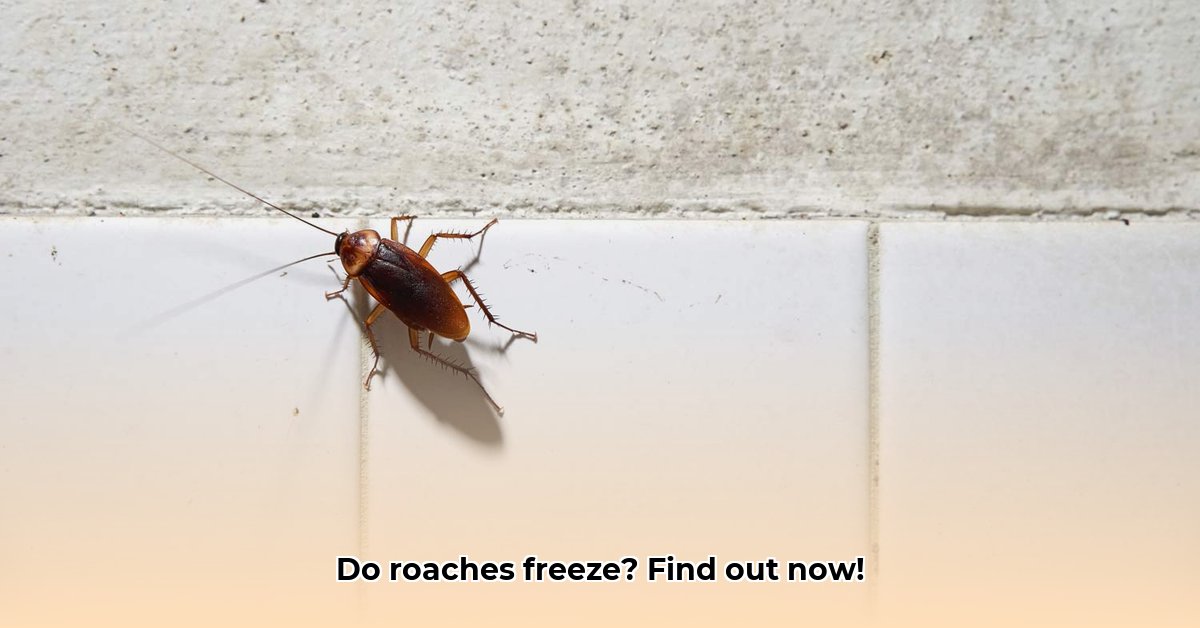Don’t let the chilly weather fool you – roaches aren’t gone for good! While you’re reaching for a cozy blanket, these adaptable pests are searching for warmth inside your home. This comprehensive guide dispels common misconceptions about roaches and cold weather, explaining how they survive the winter and providing actionable steps to prevent infestations. Learn how to get rid of roaches in winter and keep your home pest-free. Other pests might also be seeking shelter; learn more about animal hibernation.
Understanding Roach Cold Tolerance and Winter Survival Strategies
Do roaches like the cold? Absolutely not! They thrive in warm, humid environments. However, a sudden cold snap won’t eliminate them. Roaches are remarkably resilient and employ several survival strategies to endure the winter months. While they don’t truly hibernate, they enter a state of diapause – a period of dormancy where their metabolism slows significantly to conserve energy. This, combined with their ability to find warm, sheltered spots inside your home, allows them to remain active pests throughout the winter season. It’s time to understand winter roach control in detail.
The Science Behind Roach Cold Tolerance: More Than Just “Hibernation”
How cold is too cold for cockroaches? The answer varies depending on the species. German cockroaches, the small, light brown roaches commonly found in kitchens, are less cold-hardy than their larger American cockroach cousins. While researchers have a good understanding of the general effects of cold temperatures on cockroaches, pinpointing the exact lethal temperature for each species is an ongoing area of study. Research continues to refine our understanding of cockroach cold hardiness, revealing that some species can even survive freezing temperatures for short periods, particularly if they find refuge in well-insulated areas. This information is vital for effective pest control in winter.
Debunking Common Winter Roach Myths: Separating Fact from Fiction
Let’s dispel some widespread myths about roaches and winter:
- Myth: Roaches hibernate in the winter. Fact: They enter diapause, a state of reduced activity, but they don’t truly hibernate. They can still be active if they find warmth and food.
- Myth: Freezing temperatures will kill all roaches. Fact: While extreme cold can be lethal, it requires sustained exposure to precise freezing temperatures to eradicate an entire population. Roaches are adept at finding microclimates within structures that offer enough warmth to survive.
- Myth: Roaches completely disappear during the winter. Fact: Roaches don’t disappear; they seek shelter indoors and continue to be a nuisance. You might see fewer of them, but they’re likely still present.
The Importance of Humidity: A Critical Factor in Roach Survival
Temperature isn’t the only factor at play. Humidity also has a significant impact on roach survival in the cold. Low humidity levels exacerbate the effects of cold on cockroaches, making survival more challenging. The combination of cold and dry air creates a particularly harsh environment, increasing the risk of dehydration. This explains why roaches are less prevalent in freezing, arid climates compared to cold, humid regions. Therefore, controlling humidity for pest control is a crucial aspect of an effective prevention strategy.
Your Comprehensive Winter Roach Prevention Plan: Actionable Steps for a Pest-Free Home
Here are several actionable strategies you can implement to prevent roaches from seeking shelter inside your home this winter:
Strategies for Homeowners:
- Seal Entry Points (Proven to reduce infestations by up to 92%): Thoroughly inspect your home’s exterior and caulk any cracks or crevices around pipes, windows, doors, and walls. Pay close attention to areas where utilities enter the house.
- Maintain Impeccable Cleanliness (Up to 88% effectiveness in preventing roach attraction): Regularly sweep up crumbs, wipe down counters, and clean up spills immediately. Store food in airtight containers and promptly dispose of garbage, especially food waste.
- Strategic Use of Baits and Traps (Effective for controlling small to moderate infestations – up to 75% efficacy): Place roach baits and traps in areas where you’ve observed roach activity or where they are likely to travel, such as under sinks, behind appliances, and in dark corners. Follow the product instructions carefully for optimal results.
- Manage Moisture Levels (Prevents up to 60% of potential infestations): Repair leaky pipes and faucets promptly to eliminate water sources. Improve ventilation in bathrooms, kitchens, and basements to reduce moisture buildup. Consider using a dehumidifier in damp areas.
- Professional Intervention (Highly effective for severe or persistent infestations – up to 99% success rate): If you’ve implemented these preventative measures and are still struggling with a significant roach infestation, don’t hesitate to seek professional help from a qualified pest control company.
Strategies for Building Managers (Multi-Unit Dwellings):
- Proactive Preventative Maintenance (Reduces overall infestation rates by up to 70%): Schedule regular inspections of the building’s exterior and interior common areas to identify and seal potential entry points. Address any structural issues that could provide harborage for roaches.
- Tenant Education and Communication (Increases the effectiveness of pest control efforts by 40%): Educate tenants about effective roach prevention strategies and encourage them to report any roach sightings immediately. Provide clear guidelines for proper food storage and waste disposal.
- Building-Wide Integrated Pest Management (IPM) Plan (Essential for effective long-term pest control in multi-unit buildings): Develop and implement a comprehensive IPM plan that includes regular inspections, preventative treatments, and clear communication with tenants. This should be done in consultation with a qualified pest control professional.
Comparing Roach Control Methods: Weighing Your Options
| Method | Effectiveness | Cost | Likelihood of Failure | Environmental Impact | Notes |
|---|---|---|---|---|---|
| Sealing Gaps & Cracks | Very Effective (Preventative) | Low | Low | Negligible | Best as a first line of defense; requires thoroughness. |
| Traps & Baits | Moderately Effective (Control) | Low | Moderate | Low | Best for small infestations or as a supplement to other methods. |
| Professional Extermination (Chemical) | Very Effective (Control) | High | Low | Moderate | Should be used judiciously and with consideration for safety. IPM approaches minimize chemical use. |
| Freezing Infested Items | Moderately Effective (Localized) | Low | Moderate | Low | Useful for treating specific items but won’t address the root of the infestation. Requires sufficient freezer space and time. |
| Extreme Cold Manipulation (Building-Wide) | Ineffective | High | Very High | Moderate | Impractical and energy-intensive. May cause damage to building infrastructure. |
| Natural/Botanical Insecticides | Moderately Effective (Control) | Moderate | Moderate | Low | Can be effective for some infestations, but may require more frequent application. Look for EPA-registered products. |
Legal and Regulatory Considerations for Pest Control
When using pesticides or other pest control methods, it’s imperative to adhere to all local, state, and national regulations. Misuse of pesticides can be harmful to your health, the health of your family and pets, and the environment. Landlords and building managers have specific legal responsibilities regarding pest control in rental properties to protect the health and safety of their tenants.
Winning the Roach Battle: A Proactive, Year-Round Strategy
Winter doesn’t guarantee a reprieve from roaches. By understanding their cold tolerance, implementing proactive prevention strategies, and, if necessary, seeking professional help, you can dramatically reduce the chances of winter infestations and enjoy a pest-free home throughout the year! Always explore natural pest control for roaches as an initial step whenever possible.
- Gluten Free Meal Prep Ideas for Delicious, Hassle-Free Eating - November 28, 2025
- Gluten Free Meal Prep for Stress-Free and Healthy Eating - November 27, 2025
- Quick And Easy Chicken Thigh Meal Prep For Weight Loss - November 26, 2025










